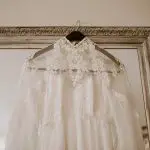Yeah, chiffon is definitely considered a luxury fabric. It started out in France in the 1700s as a silk fabric just for the elite crowd. Over the years, chiffon became a symbol of sophistication and elegance, especially popular in 1920s fashion and in Hollywood during the 1930s. Even though there are now different kinds like polyester and cotton chiffon, silk chiffon remains the top choice for luxury because of its beautiful sheer and airy quality. It's got this floaty, ethereal vibe that makes it perfect for fancy evening gowns. I'm always amazed at how something so delicate can elevate a look so much. There's a lot more to see why chiffon holds such a fancy status!
Table of Contents
Key Takeaways
- Chiffon originated as a luxury item for the elite, often used in high-end fashion.
- Silk chiffon, a common type, is prized for its refined, luxurious feel.
- Commonly featured in designer collections and couture, highlighting its premium status.
- The fabric's sophisticated drape and sheer appearance contribute to its luxurious image.
- Though polyester chiffon provides a more affordable option, silk chiffon remains associated with luxury.
History of Chiffon
Chiffon's origin dates back to the early 1700s in France, where it was first crafted as a lightweight, sheer fabric made from silk. Initially, it was a luxury item used predominantly by the elite, showcasing its exclusivity and high status. The fabric's name, 'chiffon,' comes from the French word for 'cloth' or 'rag,' which is quite ironic considering its lavish history and delicate properties.
As I've come to understand, the making of chiffon involved a meticulous and labor-intensive process, which justified its position among the high ranks in fashion and society. Due to its fine weaving and lightness, it became popular for making elegant scarves, blouses, and evening wear that demanded a graceful flow and an airy feel.
Over the years, chiffon spread beyond France, gaining popularity worldwide. It became a symbol of refinement in women's fashion during the 20th century, especially in the flapper era of the 1920s and later in the glamorous Hollywood scenes of the 1930s and 1940s. Each period highlighted chiffon's versatility and its ability to add a touch of sophistication to any garment, making it an enduring favorite in the fashion industry.
How Chiffon Is Made
To understand how chiffon is made, we start by examining the materials and processes involved in its production. The fabric begins its journey as raw materials, typically silk, but it can also be made from synthetic fibers like polyester. The magic happens during the weaving process, which is quite intriguing and sets chiffon apart from other fabrics.
| Step | Description | Emotional Impact |
|---|---|---|
| Spinning | Fibers are spun into fine threads. | Awe at the delicate precision |
| Twisting | Threads are tightly twisted. | Tension in creation |
| Weaving | Threads are woven in a mesh-like pattern. | Amazement at the complexity |
| Dyeing | Fabric is dyed to various hues. | Joy in vibrant colors |
| Finishing | Final touches enhance the feel. | Satisfaction in perfection |
The weaving employs a plain weave technique, but what's special is the high twist of the yarns, which gives chiffon its slight puckering and rough feel. This method creates a mesh-like effect, making the fabric both see-through and airy. Finishing touches often include dyeing, which adds vibrant colors and patterns, turning plain fabric into a mesmerizing visual experience. The entire process requires meticulous attention to detail, ensuring every inch of chiffon meets the high standards expected from such a graceful textile.
Types of Chiffon
Now, let's talk about the different types of chiffon.
You'll find various chiffon fabric varieties, each with unique qualities and uses.
We'll also look at some popular chiffon blends and see why they're favored in fashion design.
Chiffon Fabric Varieties
Exploring the different types of chiffon, you'll find they vary widely in source material and texture. From silk to synthetic fibers, each type brings its own unique qualities to the table.
Here's a quick guide to help you get a grip on the main varieties:
| Type | Source Material |
|---|---|
| Silk Chiffon | Natural silk fibers |
| Polyester Chiffon | Synthetic fibers |
| Cotton Chiffon | Natural cotton fibers |
Silk chiffon is the most luxurious, known for its fine weave and sumptuous feel. Polyester chiffon, on the other hand, is more durable and often more affordable, making it a popular choice for everyday wear. Cotton chiffon blends the breathability of cotton with the lightness of chiffon, perfect for casual outfits.
Popular Chiffon Blends
One popular choice among designers is the blend of silk and polyester chiffon, which combines the luxury of silk with the durability of polyester. This mix isn't just about longevity; it also helps maintain silk's soft touch while being easier on the wallet. It's a win-win for both high fashion and practical wear.
Another favorite is cotton chiffon, known for its breathability and softer texture compared to the pure synthetic versions. It's perfect for those balmy days when you want something light but stylish.
Then there's rayon chiffon, which drapes beautifully and mimics silk's glossy appearance at a lower cost. It's ideal for flowing dresses and tops where movement is key but budget constraints are real.
Chiffon in High Fashion
Chiffon's elegance and versatility make it a staple in the collections of top fashion designers. I've always noticed how this fabric makes frequent appearances on high-profile runways and in couture collections. Its sheer texture and lightness allow for layers that flow beautifully, creating that ethereal look many designers covet. It's not just about aesthetics; chiffon's ability to blend with both casual and formal designs makes it incredibly valuable in the fashion world.
When I look at fashion shows, chiffon is everywhere—from intricate evening gowns to chic cocktail dresses. Designers often use it to add a touch of sophistication without the heaviness some luxury fabrics can have. It drapes wonderfully, which is ideal for creating volume without bulk. This characteristic is essential for achieving those dramatic, swooping silhouettes that catch every eye in the audience.
Moreover, despite its delicate appearance, chiffon is surprisingly durable, which adds to its appeal for high fashion. It holds up well under the various treatments and dyes that designers use to bring their visions to life. This resilience means that while chiffon gowns look delicate and light, they're perfectly practical for the grandest occasions.
Comparing Chiffon With Other Fabrics
While chiffon offers unique advantages, comparing it to other fabrics reveals a broader spectrum of uses and qualities. For starters, let's look at cotton. Cotton is more breathable and durable than chiffon, making it ideal for everyday wear. It's also easier to care for, which is a big plus for a lot of us.
Then there's silk, which, like chiffon, is often seen in luxury garments. Silk is heavier and provides a sleek, smooth feel that chiffon can't match. However, chiffon wins when it comes to a sheer, floaty appearance, which is perfect for layering and creating soft silhouettes.
Another common fabric comparison is with polyester. Polyester chiffon is more robust and less expensive than silk chiffon, but it doesn't offer the same softness or natural feel. Yet, it holds color well and resists wrinkles better than natural chiffon, which can be quite handy.
Each fabric serves its purpose and has its place in fashion. Understanding these differences helps us choose the right fabric for our needs, ensuring both satisfaction and style. So, while chiffon holds its own in the luxury fabric category, other materials might suit different needs better.
Care and Maintenance Tips
Taking care of chiffon isn't as tricky as you might think, but it does need some special attention.
I'll show you how to wash it properly so it stays looking its best.
We'll also talk about the best ways to store chiffon to avoid damage and wrinkles.
Proper Washing Techniques
To keep your chiffon looking its best, always hand wash it gently in cool water. Use a mild detergent that's designed for delicate fabrics. Never wring or twist the chiffon, as it can damage the fibers. Instead, after washing, lay the fabric flat on a clean, dry towel, roll it up, and gently press to remove excess water. This method ensures the fabric isn't stretched or misshapen.
I also avoid using bleach or fabric softeners, which can break down the material over time. Instead, I opt for a small amount of gentle soap. Drying chiffon in a dryer is a no-go for me; I always air dry it, away from direct sunlight to prevent fading and keep it looking luxurious.
Storing Chiffon Correctly
Proper storage of chiffon is crucial to maintain its elegance and texture. I've found that the best way to store chiffon is by hanging it on padded hangers. This avoids creases and preserves the delicate fabric. If drawer storage is my only option, I make sure to use acid-free tissue paper to gently fold the chiffon. This prevents any color transfer or damage from other materials.
I also keep my chiffon away from direct sunlight and moisture. This helps in avoiding any fading or mildew. Regular checks are a good idea too, just to ensure there aren't any pests or unwanted wrinkles setting in. With these simple steps, I can keep my chiffon looking flawless for years.
Chiffon's Market Availability
Over the years, chiffon has become widely available in both high-end boutiques and mainstream stores. It's no longer just a symbol of luxury secluded to the elite. Nowadays, I can easily find chiffon garments or fabric rolls in numerous local shops and even online platforms. This widespread availability doesn't mean that all chiffon is created equal, though. The quality, texture, and origin of the chiffon still play huge roles in its pricing and perceived luxury.
High-quality silk chiffon, for instance, often retains a higher price tag and is more likely found in designer stores or specialized fabric shops. It's sought after for its finesse and softness, which are unbeatable. But there's also polyester chiffon, which is much more affordable and accessible. It's everywhere—from chain fashion stores to online discount bins. Polyester chiffon offers a similar sheer and lightweight feel, which makes it a popular alternative for those who prioritize budget over natural fibers.
Understanding this range in quality and availability has helped me better navigate where and how to buy chiffon, depending on the needs of my projects. Whether I'm looking for luxury or practicality, I know exactly where to look and what to expect in terms of cost and quality.
Frequently Asked Questions
Can Chiffon Be Dyed at Home Effectively?
Yes, I've successfully dyed chiffon at home using fabric-specific dyes. It's important to follow the instructions carefully and use the right type of dye for the best results. Patience is key!
Is Chiffon Suitable for Winter Clothing?
Chiffon's like a whisper of fabric, so it's not my go-to for chilly weather. It's too sheer and light to trap heat, making it less suitable for winter unless layered significantly.
Are There Eco-Friendly Alternatives to Traditional Chiffon?
Yes, there are eco-friendly alternatives to traditional chiffon, like those made from recycled polyester or organic silk. I'm exploring these options to reduce my environmental footprint while enjoying chiffon's elegant drape and feel.
Does Chiffon Cause Allergies or Skin Irritations?
Chiffon can cause allergies, especially if it's synthetic. I've found that people with sensitive skin might react to the chemicals used during manufacturing. It's always best to check the fabric composition first.
How Does Chiffon React to Different Climate Conditions?
Chiffon adapts well to various climates; it's breathable in heat and layers nicely in cold. However, it doesn't insulate well alone, so it's best combined with other fabrics in cooler temperatures.
- How to Properly Cut and Place Guipure Lace Motifs - June 25, 2025
- A Step-by-Step Guide to Washing Guipure Lace Without Damaging It - June 25, 2025
- How to Sew With Guipure Lace: 10 Expert Tips for a Flawless Finish - June 25, 2025





